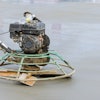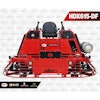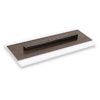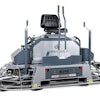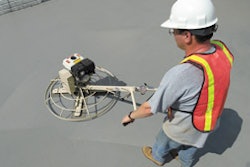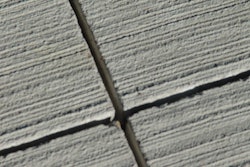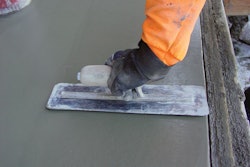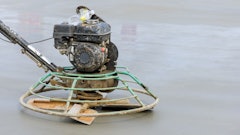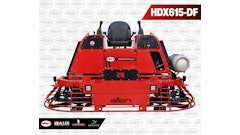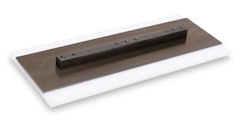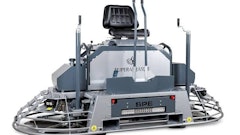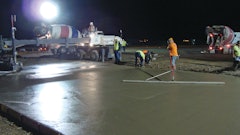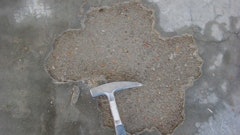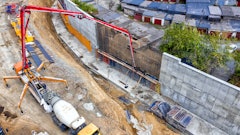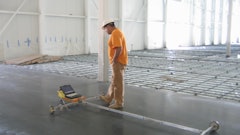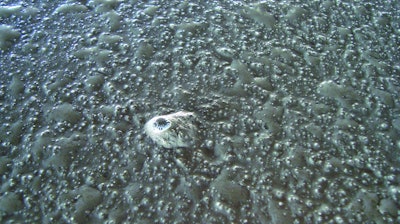
Building owners expect steel-troweled floors to be smooth, hard, attractive, and free of surface defects. As you know, easier said than done. With environmental conditions changing daily and perhaps hourly, flatwork finishers must be able to read the concrete and respond appropriately to avoid surface defects.
Avoid Premature Finishing
Wait to start power floating until the bleed water sheen has disappeared and the concrete has stiffened sufficiently to support a finisher with no more than a 1/4-in. footprint indentation. Failure to do so results in bleed water being finished into the top surface or the surface being prematurely sealed.
Do Not Finish Bleed Water Into the Surface
Bleed water is extra mix water that rises and collects on the surface of the concrete when the bleed rate of the concrete exceeds the surface evaporation rate. Finishing the bleed water into the top surface increases the water to cementitious material (w/cm) ratio on the top surface, which decreases the surface strength of the concrete and makes the surface more prone to premature wear, dusting and crazing. Other causes that produce the same effect include too much mix water, high w/cm ratios, overworking overly wet mixes, premature floating, improper or inadequate troweling, and inadequate curing.
If surfaces have stiffened or hardened sufficiently for power floating but the bleed water has not evaporated, drag a rubber hose or compressor hose across the surface and remove the water. Also, do not add and finish water into the surface to facilitate finishing because the surface has dried due to rapid evaporation. Finishing added water into the top surface has the same detrimental effects as finishing bleed water into the surface, as seen in Image 1 (below).
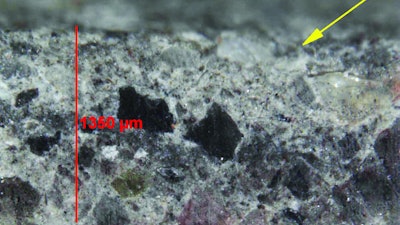 Image 1. High w/cm paste at the top of a slab that exhibited premature wear. The yellow arrow points to the top of the slab and the vertical red bar measures the depth of the paste affected by finishing. The soft, white paste at the top indicates high w/cm while the darker paste below it is typical densification from hard troweling.
Image 1. High w/cm paste at the top of a slab that exhibited premature wear. The yellow arrow points to the top of the slab and the vertical red bar measures the depth of the paste affected by finishing. The soft, white paste at the top indicates high w/cm while the darker paste below it is typical densification from hard troweling.
Dusting is the development of a fine powdery material consisting of water, cement, and fine particles that easily rubs off the top surface of interior floors. Mixing bleed or added water into the surface dilutes the mortar phase of the concrete and creates a thin, weak layer of mortar called laitance along the top surface. Other causes of dusting are overusing vibrating screeds, finishing overly wet mixes, insufficient cement, excessive clay or dirt in the aggregates, using dry cement to soak up bleed water, carbonation of the surface related to unvented heaters, freezing of the surface, and inadequate curing.
Crazing is the chicken-wire-like pattern of fine cracks that are barely visible and sometimes only visible when the concrete is drying after the surface has been wet. Since crack depths are very shallow, this form of surface cracking is primarily an aesthetic concern. Crazing seldom creates structural or serviceability issues, even for floors exposed to heavy forklift traffic. Crazing is caused by minor surface shrinkage related to rapid surface drying and wetting-and-drying cycles. Many of the causes listed above for dusting also contribute to crazing, especially overworking overly wet mixes and finishing bleed or added water into the top surface.
Do Not Trap Bleed Water & Air
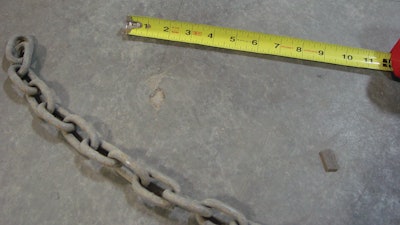 Sounding or dragging a heavy chain across the floor is the simplest means to find surface blisters and delamination.
Sounding or dragging a heavy chain across the floor is the simplest means to find surface blisters and delamination.
Premature sealing often occurs when the top surface stiffens due to surface drying or the top surface is setting faster than the underlying concrete. Top down setting often occurs when the ground temperatures are cool but the ambient conditions are warm and sunny. When this happens, flatwork finishers mistakenly believe the slab is ready to be power floated or troweled. However, the bleed water and air are still rising. If the finishers seal the surface prematurely, then rising water and air become trapped beneath the surface.
To offset early surface drying and top down setting, plan ahead and be prepared for these situations. Use water foggers and evaporation retarders to avoid early surface drying. Offset top-down setting by warming the base material or accelerating concrete setting with chemical admixtures. Be aware of these challenging conditions and do not seal the surface during bull floating or restraightening and wait until bleeding has ceased before power floating.
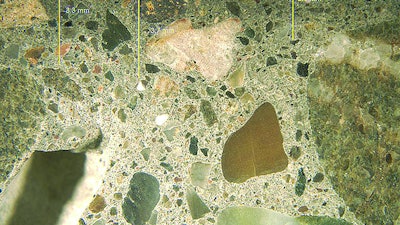 Image 2. A polished cross section through a slab with a hard trowel finish. The yellow bars show the depth of darkened paste that is indicative of densification. The scale bar is about 40 mil long.
Image 2. A polished cross section through a slab with a hard trowel finish. The yellow bars show the depth of darkened paste that is indicative of densification. The scale bar is about 40 mil long.
Surface Densification
Power troweling should create dense, smooth, hard surfaces. By progressively increasing the angle of the steel trowel blades against the top surface of a slab, the surface mortar is increasingly densified by expelling free water and air. Proper troweling produces a densified surface layer (DSL) with typical thicknesses varying between about 1 to 4 mm (3/34 to 5/32 in.). As shown in Image 2 (above), the DSL is identified by its dark color as compared to the underlying concrete. The dark color is also visible on the top surface of the slab and commonly referred to as "burnishing" or a "burnished" surface.
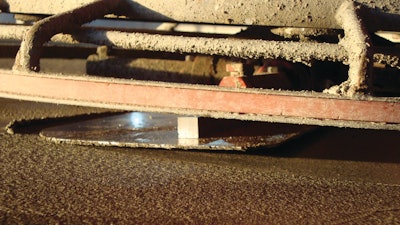 Increasing the trowel blade angle reduces the contact area or footprint of the blade which increases the blade pressure on the surface. Increasing the pressure helps densify the top surface.
Increasing the trowel blade angle reduces the contact area or footprint of the blade which increases the blade pressure on the surface. Increasing the pressure helps densify the top surface.
Floors subject only to light troweling or floors with DSL thicknesses less than 1 mm (3/64 in.) may be prone to premature surface wear, especially if exposed to a high frequency of small, hard-wheeled forklift traffic.
 Image 3. This photo shows the top of a drilled core with trowel chatter, crazing and an uneven surface. The photo is about 19 mm from top to bottom.
Image 3. This photo shows the top of a drilled core with trowel chatter, crazing and an uneven surface. The photo is about 19 mm from top to bottom.
Protect Surfaces From Early Drying
To avoid surface defects associated with drying of the surface including crusting, crazing, dusting, and reduced surface strength, favorable moisture and temperature conditions must be maintained throughout the finishing process. Plastic-shrinkage cracking is typically not a problem for interior slabs because power floating and troweling keeps closing surface tears and cracks caused by surface drying. However, other surface drying defects can occur when surfaces are not protected from early drying and final curing is delayed.
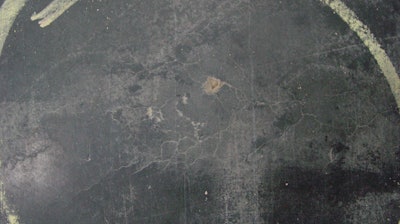 Cracking, crazing and delaminations are sure signs that surface drying occurred while the underlying concrete was still plastic.
Cracking, crazing and delaminations are sure signs that surface drying occurred while the underlying concrete was still plastic.
To offset early surface drying, use water foggers and evaporation retarders. Do not use evaporation retarders as a finishing aid. That is, do not apply evaporation retarders to facilitate finishing because the surface has dried and become too stiff to finish. After mixing, evaporation retarders are typically 90 percent water so it is not acceptable to finish or mix an evaporation retarder into the top surface of the concrete. Start final curing immediately after troweling or saw cutting.
Premature finishing can lead to costly surface defects while waiting too long to start power floating and troweling may result in unacceptable floor flatness and surface finishes. The true challenge in finishing interior concrete floors is finding the window of finishability regardless of the changing and adverse placing conditions.

